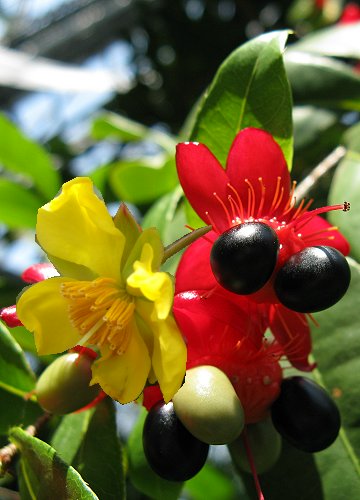
|
|
Mickey Mouse bush
( Ochna serrulata). Flower, sepals and fruits.
|
Mickey Mouse bush - Ochna serrulata
Ochna is a genus comprising 86 species of evergreen trees, shrubs and shrublets belonging to the family Ochnaceae. These species are native to tropical woodlands of Africa or Asia. Species of this genus are usually called Ochnas or Mickey-mouse plants, a name coming from the shape of the drupelet fruit. The name of this genus comes from Greek Ochne, a word used by Homer and meaning wild pear.
Some species, especially Ochna serrulata (bird's eye plant), are widely cultivated as a decorative plant.
Ochna serrulata (commonly known as the mall-leaved plane, carnival ochna, Bird's Eye Bush or Mickey Mouse bush due to the plant's bright-red sepals, which resemble the face of Mickey Mouse) is an ornamental garden plant of the Ochnaceae family which is indigenous to South Africa. It is planted in southern African gardens and is an invasive species in Australia and New Zealand.
Ochna serrulata was first described by the German naturalist Christian Ferdinand Friedrich Hochstetter, and given its current binomial name by Wilhelm Gerhard Walpers.
The genus name Ochna comes from Ochne, the ancient Greek name for the wild pear, because the leaves of this genus where thought to resemble those of the wild pear. The specific name serrulata refers to the saw-toothed leaf margins.
The plant is native to the forest areas of South Africa. It occurs throughout the country, from Cape Town in the south, along the east coast as far as Kwazulu-Natal, and inland through Swaziland and Gauteng. This tough, adaptable shrub grows in sunny, open positions as well as in the shade of deep forest.
It has been widely cultivated outside of South Africa as an ornamental garden plant, and has become a weed in New South Wales and southern Queensland in eastern Australia, where it is found near human habitation in and around large towns and cities.
This is certainly a shrub that every gardener should have in their garden, not only because of its beautiful yellow flowers, but also because of its attractive fruits. These are shiny black and berry-like, suspended below bright-red sepals in a way that resembles the face of Mickey Mouse, hence the common name Mickey Mouse bush.
Ochna serrulata is a small shrub of 1 to 2 m in height, but does occasionally grow up to 6 m so it can also be referred to as a small tree. It has a slender stem with smooth, brown bark. The branches are covered with small, raised, light-coloured dots. The leaves are elliptic, 13-50 mm long, but occasionally narrow with blunt or rounded tips and a rounded base. The leaf margins are toothed with upright pointed teeth, and the midrib and the lateral veins are conspicuous above. The young spring foliage is a beautiful pinkish-bronze, maturing to glossy green.
This beautiful shrub is covered with fragrant yellow blossoms in spring (September-November), each flower about 20 mm in diameter. Although the petals drop quite soon, they make an excellent show while open. The fruits are 5 to 6 mm, almost spherical, berry-like fruits, green at first, shiny black when mature. They are attached to the sepals, which are persistent, and whilst the fruit has been developing, the sepals have enlarged and turned bright red, in most cases turning the whole bush red. In Kirstenbosch the fruits start ripening in early summer (November) and the red sepals last until late summer (January-February).
The Zulu people use a decoction of the root to treat children suffering from bone diseases or gangrenous rectitis.
O. serrulata is a weed in parts of eastern Australia with a potential to spread from its current range. In New Zealand it is listed on the National Pest Plant Accord prohibiting its sale, commercial propagation and distribution.
Source:
http://en.wikipedia.org/wiki/Ochna
http://en.wikipedia.org/wiki/Ochna_serrulata
http://www.plantzafrica.com/plantnop/ochnaserrulat.htm
